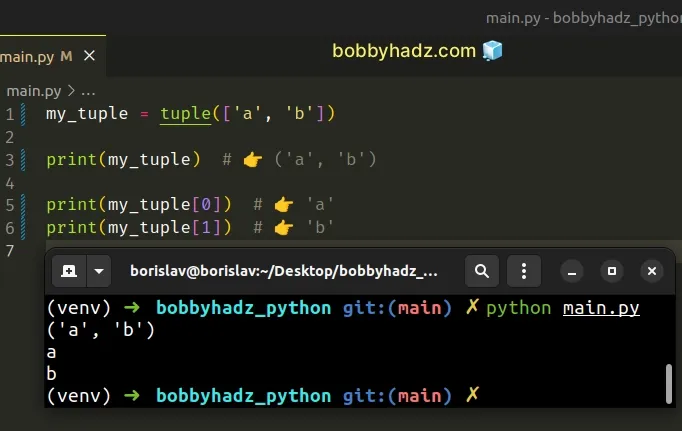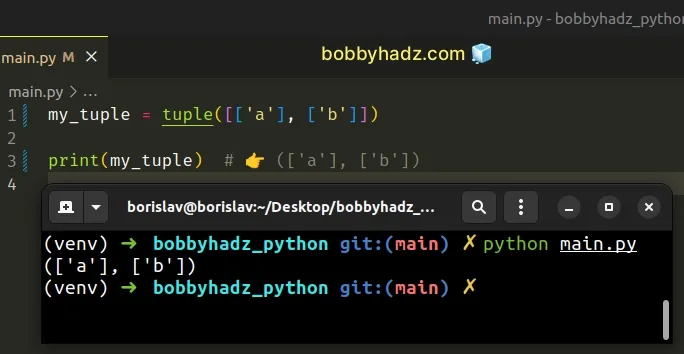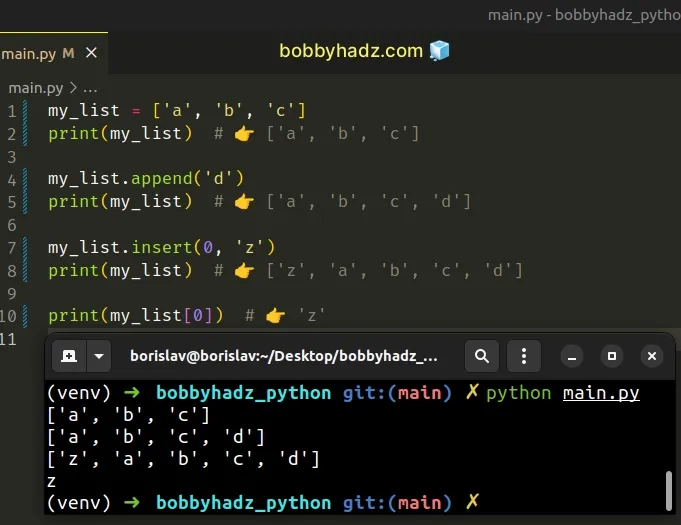TypeError: 'X' expected at most 1 argument, got 2 [Solved]
Last updated: Apr 8, 2024
Reading time·5 min

# Table of Contents
- TypeError: TUPLE expected at most 1 argument, got 2
- TypeError: INPUT expected at most 1 argument, got 3
- TypeError: LIST expected at most 1 argument, got 2 in Python
# TypeError: tuple expected at most 1 argument, got 2
The Python "TypeError: tuple expected at most 1 argument, got 2" occurs when
we pass multiple arguments to the tuple() class.
To solve the error, pass an iterable, such as a list containing the arguments.

Here is an example of how the error occurs.
# ⛔️ TypeError: tuple expected at most 1 argument, got 2 my_tuple = tuple('a', 'b')
The tuple class takes at most 1 argument - an iterable.
# Passing multiple values in a list to the tuple() class
We can pass multiple values in a list to the tuple class.
my_tuple = tuple(['a', 'b']) print(my_tuple) # 👉️ ('a', 'b') print(my_tuple[0]) # 👉️ 'a' print(my_tuple[1]) # 👉️ 'b'

Python indexes are zero-based, so the first item in a tuple has an index of 0,
and the last item has an index of -1 or len(my_tuple) - 1.
# Creating a tuple that has lists as elements
If you need to create a tuple containing lists as items, pass a two-dimensional list to the tuple() class.
my_tuple = tuple([['a'], ['b']]) print(my_tuple) # 👉️ (['a'], ['b'])

# How tuples are constructed in Python
Tuples are constructed in multiple ways:
- Using a pair of parentheses
()creates an empty tuple - Using a trailing comma -
a,or(a,) - Separating items with commas -
a, bor(a, b) - Using the
tuple()constructor
# Tuples are immutable
Note that tuples are immutable, so if you have to mutate a sequence, you have to
use a list instead.
my_list = ['a', 'b', 'c'] print(my_list) # 👉️ ['a', 'b', 'c'] my_list.append('d') print(my_list) # 👉️ ['a', 'b', 'c', 'd'] my_list.insert(0, 'z') print(my_list) # 👉️ ['z', 'a', 'b', 'c', 'd'] print(my_list[0]) # 👉 'z'

Note that lists are created using square brackets.
The list.append() method adds an item to the end of the list.
The method returns None as it mutates the original list.
If you need to add an item at a specific index, use the insert() method.
The list.insert() method inserts an item at a given position.
The method takes the following 2 parameters:
| Name | Description |
|---|---|
| index | The index of the element before which to insert |
| item | The item to be inserted at the given index |
# Table of Contents
- TypeError: INPUT expected at most 1 argument, got 3
- TypeError: LIST expected at most 1 argument, got 2 in Python
# TypeError: input expected at most 1 argument, got 3
The Python "TypeError: input expected at most 1 argument, got 3" occurs when
we pass multiple arguments to the built-in input() function.
To solve the error, use a formatted string literal to concatenate the arguments into a single string.

Here is an example of how the error occurs.
w = 'name' # ⛔️ TypeError: input expected at most 1 argument, got 3 s = input('Your ', w, ': ')
input() built-in function expects at most 1 argument, so we have to concatenate the arguments into a single string.# Use the addition (+) operator to solve the error
One way to solve the error is to use the addition (+) operator to concatenate the strings.
w = 'name' s = input('Your ' + w + ': ') print(s)
The addition (+) operator can be used to concatenate strings.
print('a' + 'b' + 'c') # 👉️ 'abc'
# Using a formatted-string literal to solve the error
An alternative approach is to use a formatted string literal.
w = 'name' s = input(f'Your {w}: ') print(s)
f.Make sure to wrap expressions in curly braces - {expression}.
This solves the error because we are passing a single, string argument to the
input() function.
The input() function takes an optional prompt
argument and writes it to standard output without a trailing newline.
s = input('Your name: ') print(s)
The function then reads the line from the input, converts it to a string and returns the result.
An alternative to providing the prompt argument is to use calls to the
print() function.
print('Your name: ') s = input() print(s)
This is very similar to passing the prompt argument to the input() function
but instead of showing the prompt on the same line, it is displayed on a
separate line.
# TypeError: list expected at most 1 argument, got 2 in Python
The Python "TypeError: list expected at most 1 argument, got 2" occurs when we
pass multiple arguments to the list() class which takes at most 1 argument.
To solve the error, use the range() class to create a range object or pass
an iterable to the list() class.

Here is an example of how the error occurs.
# ⛔️ TypeError: list expected at most 1 argument, got 2 my_list = list(0, 5)
The list() class expects to get called with at most 1 argument - an iterable.
my_tuple = ('a', 'b', 'c') my_list = list(my_tuple) print(my_list) # 👉️ ['a', 'b', 'c']
# Creating a range of integers
If you meant to create a range of integers, use the range() class.
my_list = list(range(0, 5)) print(my_list) # 👉️ [0, 1, 2, 3, 4]
And if you meant to create a list containing multiple items, pass the items in
an iterable in the call to the list() class.
my_list = list(['a', 'b', 'c']) print(my_list) # 👉️ ['a', 'b', 'c']
The list class takes an iterable and returns a list object.
The range() class is commonly used for looping a specific number of times in for loops and takes the following parameters:
| Name | Description |
|---|---|
start | An integer representing the start of the range (defaults to 0) |
stop | Go up to, but not including the provided integer |
step | Range will consist of every N numbers from start to stop (defaults to 1) |
If you only pass a single argument to the range() constructor, it is
considered to be the value for the stop parameter.
for n in range(5): print(n) result = list(range(5)) # 👇️ [0, 1, 2, 3, 4] print(result)
start argument is omitted, it defaults to 0 and if the step argument is omitted, it defaults to 1.If values for the start and stop parameters are provided, the start value
is inclusive, whereas the stop value is exclusive.
result = list(range(1, 5)) # 👇️ [1, 2, 3, 4] print(result)
If the value for the stop parameter is lower than the value for the start
parameter, the range will be empty.
result = list(range(1, 0)) # 👇️ [] print(result)
# Additional Resources
You can learn more about the related topics by checking out the following tutorials:
- How to convert a Tuple to an Integer in Python
- How to convert a Tuple to JSON in Python
- Find Min and Max values in Tuple or List of Tuples in Python
- Get the Nth element of a Tuple or List of Tuples in Python
- Creating a Tuple or a Set from user Input in Python
- How to Iterate through a List of Tuples in Python
- Write a List of Tuples to a File in Python
- AttributeError: 'tuple' object has no attribute X in Python
- TypeError: 'tuple' object does not support item assignment
- TypeError: 'tuple' object is not callable in Python [Fixed]

